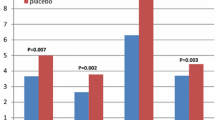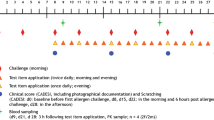Abstract
Background: Beta-2 agonists are potent inhibitors of mast cell degranulation in vitro. Intradermally injected they also inhibit mast cell activation in human skin in vivo. To what extent orally administered β2-agonists inhibit mast cell degranulation and allergic skin responses in vivo in daily recommended doses remains unclear.
Purpose: The main purpose was to study the effects of oral administered terbutaline and bambuterol on allergen- and codeine-induced histamine release and skin responses in intact human skin in vivo. In addition, control studies were carried out with intradermally injected terbutaline.
Methods: Ten allergic subjects were randomized to receive bambuterol (10 mg tablets twice daily), terbutaline (7.5 mg controlled release tablets twice daily) and corresponding placebo for 5 days with a washout phase of 3 days between treatments in a double-blind, double-dummy, cross-over trial. The patients were studied at the fifth day of each regimen, i.e. at day 5, 13, and 21. Allergen- and codeine-induced histamine release was measured by microdialysis technique. Wheal and flare reactions to allergen, codeine, and histamine were measured planimetrically. Measurements were performed in the morning on day 5 on each regimen before medication and for additional 5 h after administration of the morning dose. In a separate series of experiments in another 10 allergic patients, 1–1,000 nM (0.05–50 pmoles) of terbutaline was injected intradermally for measurement of histamine release, prostaglandin D2 (PGD2) synthesis and skin responses.
Results: Neither orally administered terbutaline nor bambuterol significantly reduced allergen- or codeine-induced histamine release. Flare reactions to allergen, codeine and histamine remained unaffected which was also the case for the majority of the wheal reactions. In comparison, intradermally injected terbutaline significantly reduced allergen-induced histamine release, PGD2 synthesis, and skin reactions. Codeine-induced histamine release remained unaffected. Terbutaline significantly reduced flare reactions to codeine and histamine with no effect on wheal reactions.
Conclusions: Terbutaline, in micromolar concentrations, was a potent inhibitor of immediate allergic skin reactions primarily due to inhibition of mast cell degranulation. However orally administered terbutaline, as the active drug itself or released from its pro-drug bambuterol, did not inhibit mast cell activation or allergic skin responses.
Similar content being viewed by others
Author information
Authors and Affiliations
Corresponding author
Additional information
Received 28 January 2003; returned for revision 7 March 2003; accepted by M. Parnham 29 April 2003
Rights and permissions
About this article
Cite this article
Petersen, L.J., Skov, P.S. Effect of terbutaline and bambuterol on immediate-type allergic skin responses and mediator release in human skin. Inflamm. res. 52, 372–377 (2003). https://doi.org/10.1007/s00011-003-1187-3
Issue Date:
DOI: https://doi.org/10.1007/s00011-003-1187-3




